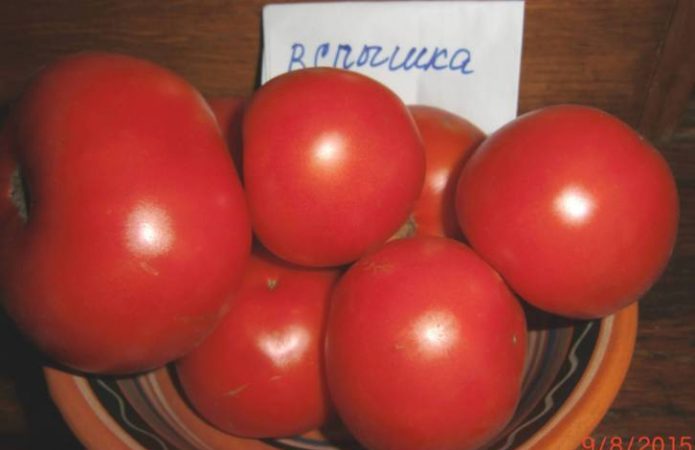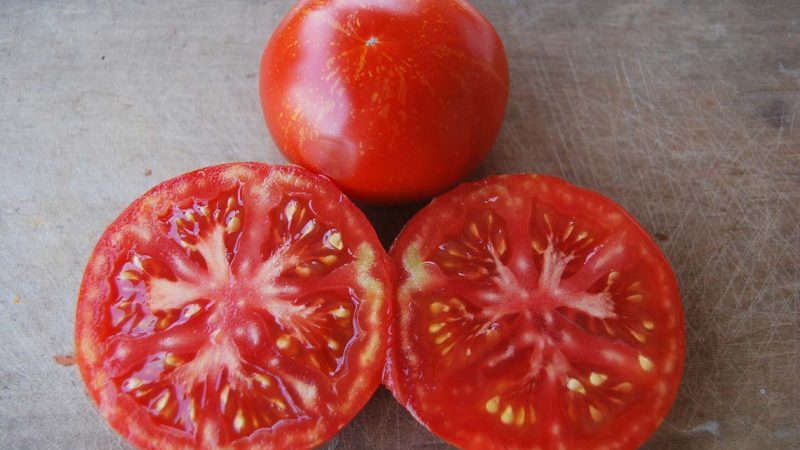Recommendations for the care of the "Flash" tomato: what can affect the yield
The tomato variety Flash fell in love with gardeners due to the sugary juicy pulp of the fruit, early ripening, resistance to diseases and weather conditions.
From the article you will learn what the varietal features and characteristics of the tomato, how to grow it correctly and how to use the crop.
The content of the article
Description and characteristics of tomato varieties
Among the varieties suitable for growing in central Russia, the Flash tomato is on the list of the best. This is an early ripening variety (the duration of the growing season is 95 days). The culture is grown in open ground and greenhouses.
With proper care, the outbreak is resistant to major pests and diseases, and adverse weather conditions.

Features of the variety:
- after the formation of 5 brushes on a stunted plant, the growth of the central apex is limited due to the formation of a flower brush;
- the average height of the bushes is 45 cm;
- tomatoes have medium-sized leaves of a dark green color;
- the first fruit cluster is formed at the level of 5 leaves;
- up to 6 fruits ripen on each cluster (weight - 100–120 g);
- the pulp contains a small amount of seeds, the fruits themselves with bright red skin and weak ribbing at the base.
By yield (from 1 m2 harvested to 6 kg) The outbreak is inferior indeterminate tomatoes, but for early determinant plants this is a high figure.
Pros and cons of the variety
Flash is popular with vegetable growers for its benefits:
- due to their low growth, the bushes do not need an additional garter, which simplifies their care;

- the culture is not afraid of adverse weather conditions;
- resistant to many diseases and pests;
- the variety has a very early ripening period and a good yield for low-growing tomatoes;
- the excellent taste of tomatoes makes them versatile in cooking: vegetables are used fresh, for processing, preservation, pickling;
- keeping quality of fruits reaches 3 weeks;
- there is an almost complete output of marketable products.
The Flash has no obvious flaws... Some farmers refer to negative qualities as:
- low yield compared to indeterminate varieties;
- thin skin of the fruit, which makes it difficult to transport and store.
How to grow
Despite its resistance to weather conditions, the Flash needs comprehensive care. The yield indicator directly depends on this.
Agricultural technology in general is simple:
- Seedlings begin to be prepared in late March - early April. The sowing date is determined taking into account the transplantation of seedlings to a permanent place no earlier than 50 days later. It is advisable to add to this period a week for seedlings and 5 days for the adaptation of plants to a new place.
- Before sowing, the planting material is soaked for 10 hours in a weak solution of potassium permanganate to disinfect it.
- Seedlings are provided with the necessary conditions for effective growth: systematic watering, loosening the soil, and fertilizing.
- Plants are taught in advance to sunlight, hardened. To do this, 10 days before transplanting into the ground, the bushes are taken out into the street, left for several hours.
- Landing in open ground is carried out in early June. Landing scheme - 40x60 cm.
- To get an early harvest, in some cases, stepchildren are removed. This will save the crop from overloading with fruits and damage to the branches.
- Watering, weeding and feeding tomatoes is systematically carried out, do not forget to loosen the soil. Fertilizers are applied every 3 weeks.
Reference! Liquid organic compounds are the best crop feed.Infusions of cow dung, chicken manure or grass cuttings are suitable.
Compact bushes of low-growing tomatoes Flash some summer residents grow in special boxes. To do this, in a small area (6x1.2 m), a rectangular wooden frame is equipped, into which fertile soil is poured.

This method of cultivation has several advantages:
- aisles do not require maintenance;
- there are convenient passages between the beds;
- the ability to install arcs for covering material that protects plants from adverse weather conditions.
Prevention of diseases and pests
Carrying out agrotechnical measures in compliance with all recommendations does not yet guarantee a high-quality harvest. When growing tomatoes, farmers are faced with plant infestation or pest attacks.
Variety Outbreak is resistant to many diseases, including late blight... However, there are certain risks, so vegetable growers are taking preventive measures.
The main fungal diseases of the culture are late blight, black leg, white leaf spot, fusarium wilting, black, white and gray rot.
To prevent infection, the following measures are taken:
- the seedlings are sprayed with copper chloride;
- remove non-viable leaves in a timely manner;
- a week before the expected planting, fertilizer is applied - "Trichodermin".
Other pathogens of tomatoes are viruses. To prevent such diseases, do the following:
- planting a crop on a site where tomatoes have not grown before;
- prevent the emergence of pests that carry viruses;
- timely clean the soil, remove weeds;
- carefully process all containers, tools and the greenhouse itself.
Another problem is the defeat of tomatoes by bacterial diseases (black bacterial, brown leaf spot, columnar and bacterial speckles). To prevent infection, planting material is treated with insecticides, antibiotics are used, and the immunity of shoots is increased.
Often, the yield of a crop decreases due to its defeat by diseases of a non-infectious nature. They are caused by an imbalance in the mineral nutrition of the bushes. To avoid this, they observe the rules and technology of planting, do not neglect fertilizers, but apply them in a balanced amount.
Important! Many summer residents feed the shoots with chlorine-free mixtures. At the same time, chlorine is not completely excluded: it can disrupt water metabolism, turgor of plant leaves. To prevent a lack of substance, a small amount of table salt is periodically added when watering the beds.
In addition to disease, insects also damage crops. The most dangerous pests for tomatoes are whitefly, bears, spider mites, wireworms, sprout flies, slugs, gnawing scoops, aphids and Colorado beetles.
Insecticides are used to protect plants (Aktar, Mospilan, Prestige, Fosbecid, Tsitkor). Effective in the fight against insects and folk methods - a solution based on laundry soap, infusion of garlic or tobacco, herbal formulations, cat flea drops, a mixture of tobacco dust, hot pepper and ash.
Reviews of gardeners

Farmers speak positively about the culture, note its unpretentiousness, early and long-term fruiting, stability and pleasant fruit taste. Here are the reviews from those who have already planted this variety.
Julia, Moscow: "When growing a Flash, the main thing is not to rush to plant seedlings: they grow quickly, outgrow and take root worse. This is generally a precocious variety. In the open field it showed itself perfectly. Of course, the yield cannot be compared with two-meter greenhouse plants, but after all, there is practically no care. Low bushes, as in the photo, some even managed without a garter, there are no problems with stepsons. I liked the tomatoes: medium in size, just right for pickling, but I didn't get it: sweet, they ate everything like that. The peel of vegetables is thin, but I don't like thick-skinned ones, I'm tired of purchased ones.They began to bear fruit early, for a long time new ones appeared. This year I will plant for sure. "
Svetlana, Voronezh: “The outbreak sown in February for an early harvest. The first fruits were taken in July. There were bushes in the greenhouse. I thought they would give the first harvest in unison and I would free the beds, but that was not the case. The flash bore fruit tirelessly until frost. In the summer it ended, but gave stepsons, continued to bear fruit on them. The tomatoes are early, medium-sized, not watery, but quite the opposite: sugary at the break and sweetish. The height in the greenhouse was about 50 cm, the bushes were quite wide. "
Conclusion
Flash is an unpretentious tomato variety, which occupies a leading position in taste and fruiting times. The culture is resistant to weather conditions, diseases, does not need a tie, has a high productivity among determinant plants (from 1 m2 to 6 kg) and early ripening of fruits. Sugar and juicy vegetables are versatile in cooking.